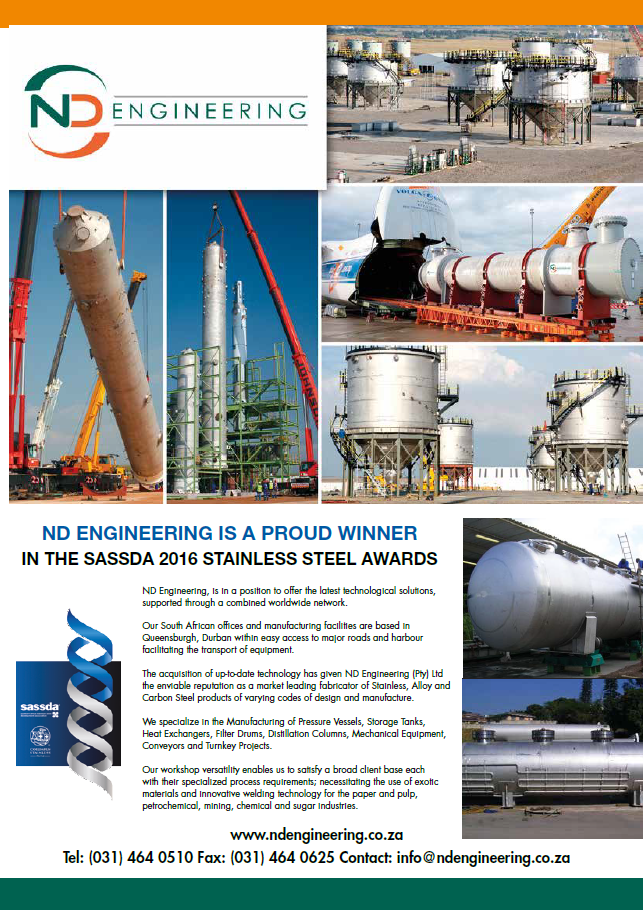A REVIEW BY JOHN CLUETT
The brewing industry is improving fabrication standards and showing flexibility under new challenges
The use of stainless steel in the brewing industry over the past three decades in southern Africa has resulted in failures of equipment caused by corrosion and structural defects. Root cause analysis has been carried out by various users, industry specialists, fabricators and academic institutions
resulting in the development of new standards in the design, fabrication and use of stainless steel for equipment and piping systems in the industry.
Publication of incidents and their findings has demonstrated the importance of due diligence as a prerequisite of internationally accepted business practice especially important in the food and beverage industry. By sharing these learnings, a reduction of incidents has been observed over the years as improved design and fabrication has been actioned by designers, fabricators and end users.
CASE STUDY 1: Consani Engineering – Process vessels at SAB Pietersburg Brewery, Polokwane, 1988
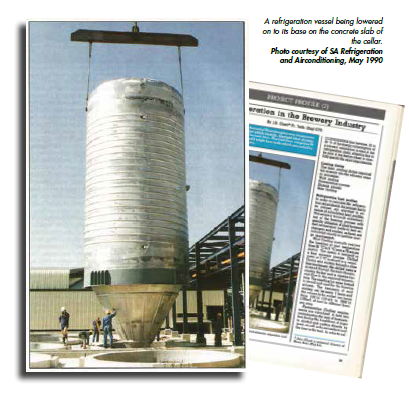 CONTEXT: The replacement of epoxy lined mild steel vessels with stainless steel was presented by SAB for the sassda 2014 Stainless Steel Awards. The application of Value Engineering and life cycle costing were applied to ensure any changes to original standards were optimised.
CONTEXT: The replacement of epoxy lined mild steel vessels with stainless steel was presented by SAB for the sassda 2014 Stainless Steel Awards. The application of Value Engineering and life cycle costing were applied to ensure any changes to original standards were optimised.
When SAB went out to tender for the design, supply and erection of the brewing equipment for the Pietersburg Brewery project, quotations from four companies were evaluated for their technical content, budgets, project plan, resources and local content. Two companies were short listed and after final evaluation, the contract was awarded to Steinecker, Germany, with Consani Engineering as the subcontractor to fabricate all stainless steel process vessels. This ensured that stainless steel from the South African stainless steel mill, Middleburg Steel & Alloys (MS&A), now Columbus Stainless, was used for all process vessels. Imported automated welding equipment was used for the cooling coils welded on to the large vessels (FV, SV, BBT). This brought the fabrication of stainless steel vessels in South Africa in line with the latest technology and legal requirements in the international food and beverage industry.
SAB received the South African Institution of Mechanical Engineers Projects & Systems Award for the Rosslyn Brewery in 1987 and for the Pietersburg Brewery in 1991. Criteria to select award winners are; the degree of South African expertise in the design and construction, the amount of equipment manufactured in South Africa, the cost of construction in relation to original estimates and the construction time in relation to the original project programme.
FABRICATION PROCESS: The original 2B finish sheets produced by MS&A were then polished before fabrication of the vessels that was carried out in the horizontal position. Automated welding of cooling coil jackets on the vessel shells was also done in the horizontal position. Insulation was carried out on site. The polished plate surfaces, covered with an adhesive plastic film to prevent scratching during fabrication, were observed to leave
a dark residue on the inner surface of the vessels that was difficult to remove with standard CIP of the vessels. Following a detailed investigation on the dark residue, it was found to contain plasticizers (a substance, typically a solvent, added to a synthetic resin to produce or promote
plasticity and flexibility and to reduce brittleness) from the adhesive plastic film embedded with residue from the polishing process. Fabricators were made aware of the findings. The use of paper inlays on stainless steel coils prevents any contamination to the surface as well as protects the surface finish.
 CASE STUDY 2: Krugersdorp Engineering – Storage vessels at SAB Prospecton Brewery, Durban, 1991
CASE STUDY 2: Krugersdorp Engineering – Storage vessels at SAB Prospecton Brewery, Durban, 1991
CONTEXT: SAB went out to tender for the supply and erection of the large storage stainless steel vessels for the Prospecton brewery expansion project. Two companies were short listed and after final evaluation, the contract was awarded to Krugersdorp Engineering. Although local sourcing of stainless steel was preferred, cost and delivery dates were considered as important in the final adjudication. Krugersdorp Engineering’s offer included the use of imported 2B coils of stainless steel and the use of a different fabrication process to that used by Consani Engineering.
FABRICATION PROCESS: Imported 2B stainless coils that did not require polishing were used. Vessels were fabricated vertically as a tower, welding the top dome and cans one on top of the other. The vessels were then placed horizontally to weld on the cone and cooling coil jackets. Insulation of vessels was carried out before transport to site. No dark residue was found on the inner surface of these vessels.
CASE STUDY 3: Repair of 20 vessels by Falcon Engineering, 2002
Con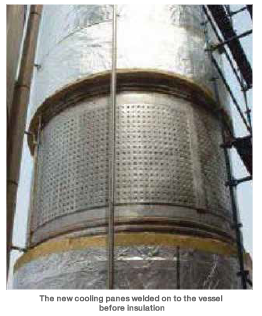 text: SAB went out to tender for the refurbishment of 20 fermenting vessels with the additions of a cooling jacket on the shell and on the cone. On pressure testing the vessels on site, the additional jackets were found to be faulty. A detailed investigation of the failure proved that the root cause was due to poor QA during design, fabrication and testing of all the vessels before being shipped from South Africa.
text: SAB went out to tender for the refurbishment of 20 fermenting vessels with the additions of a cooling jacket on the shell and on the cone. On pressure testing the vessels on site, the additional jackets were found to be faulty. A detailed investigation of the failure proved that the root cause was due to poor QA during design, fabrication and testing of all the vessels before being shipped from South Africa.
Fabrication process: Remedial work was urgently required to make the vessels usable and safe for operations in the breweries. New cooling jackets were fabricated by Falcon Engineering (Winner of sassda Stainless Steel Award 2002) in South Africa and shipped out to the three locations along with all required personnel, fabrication and testing resources. The logistics and fixing of new cooling jackets required a complex cutting out of the damaged shells and then welding the sections of the new jackets on the vessels that were in place at the operational brewery. Testing during the fabrication, final pressure testing and re-insulation and cladding of vessels were all carried out to the required quality and legal standards. The work was completed on time and to budget.
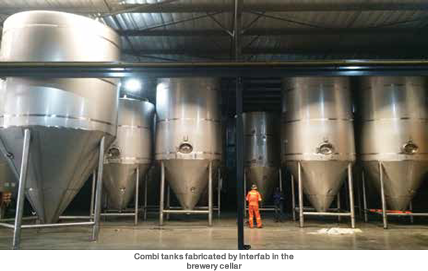 CASE STUDY 4: Interfab Combi tanks at Redrock Brewery, Johannesburg, 2015
CASE STUDY 4: Interfab Combi tanks at Redrock Brewery, Johannesburg, 2015
Fabrication process: All the vessels were fabricated at Interfab and installed at this Craft Brewery that is designed to the highest industry standards. In a period of one year this entire brewery project went from start of civils work to first brew.
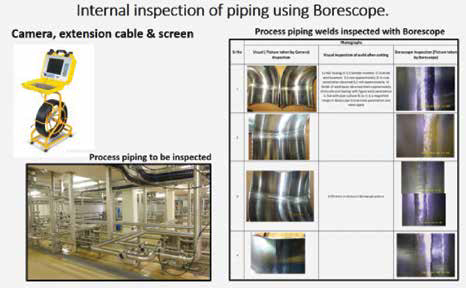 CASE STUDY 5: Getting closer to the inside of welded piping or vessels to view and measure the required hygienic standards or evidence of corrosion.
CASE STUDY 5: Getting closer to the inside of welded piping or vessels to view and measure the required hygienic standards or evidence of corrosion.
Context: SAB has been researching the causes of asset failures over the years. The first documented evidence was presented and published in 1985, “Corrosion in a Brewery Environment”. Since then ongoing research has been carried out in academia and in the production environment. These investigations have also focused on corrosion of all equipment and piping systems. More recently investigations on the use of certain chemicals used for cleaning and sanitising in brewery and soft drinks has shown excessive corrosion of stainless steel surface and at the heat affected zones of welds. Internal inspection of these surfaces has been greatly enhanced with the use of the Borescope as the camera travels inside the vessels and piping systems allowing a close up view of the surface that can be observed on the external screen.
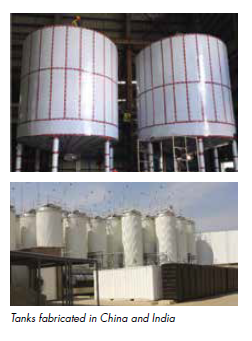 CASE STUDY 6: Competition from overseas stainless steel fabricators
CASE STUDY 6: Competition from overseas stainless steel fabricators
Context: SABMiller carried out detailed technical and commercial audits, based on corporate standards, at fabricators’ facilities in China, India and Europe with a view to having suppliers that offered competitive and comparative aspects to the design, fabrication and erection of brewing and packaging equipment for their global operations. These suppliers are assessed when tendering for equipment along with other suppliers that have serviced the company over the years.
ACKNOWLEDGEMENTS
SAB / SABMilller management has, over the years, encouraged the detailed research and publication of their
projects.
Sharing learnings from these interactive collaborations with all stakeholders has enhanced their quality and excellence in engineering, acknowledged internationally and showed the importance of due diligence.
The collaboration with sassda over the years has been a key factor in achieving the ongoing success in the use
and application of stainless steel in the brewing industry.


